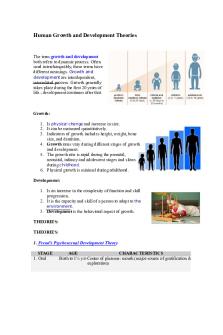Lecture 4 - Classic Theories of Economic Growth and Development (Part 2) PDF

| Title | Lecture 4 - Classic Theories of Economic Growth and Development (Part 2) |
|---|---|
| Course | Development Economics 1 |
| Institution | Swansea University |
| Pages | 3 |
| File Size | 190 KB |
| File Type | |
| Total Downloads | 60 |
| Total Views | 127 |
Summary
Lecture 4 - Classic Theories of Economic Growth and Development (Part 2)...
Description
Lecture 4 - Classic Theories of Economic Growth and Development (Part 2) 3.4 The International-Dependence Revolution • The neocolonial dependence model – Legacy of colonialism, Unequal power, Core-periphery • The false-paradigm model – Pitfalls of using “expert” foreign advisors who misapply developedcountry models • The dualistic-development thesis – Superior and inferior elements can coexist; Prebisch-Singer Hypothesis • Criticisms and limitations – Does little to show how to achieve development in a positive sense; accumulating counterexamples 3.5 The Neoclassical Counterrevolution: Market Fundamentalism • Challenging the Statist Model: Free Markets, Public Choice, and MarketFriendly Approaches – Free market approach – Public choice approach – Market-friendly approach • Main Arguments – Denies efficiency of intervention – Points up state owned enterprise failures – Stresses government failures – Traditional neoclassical growth theory - with diminishing returns, cannot sustain growth by capital accumulation alone 3.6 Classic Theories of Development: Reconciling the Differences • Governments do fail, but so do markets; a balance is needed • Must attend to institutional and political realities in developing world • Development economics has no universally accepted paradigm • Insights and understandings are continually evolving o Each theory has some strengths and some weaknesses Effect of Increases in Physical and Human Resources on the Production Possibility Frontier:
Effect of Growth of Capital Stock and Land on the Production Possibility Frontier:
Effect of Technological Change in the Agricultural Sector on the Production Possibility Frontier:
Effect of Technological Change in the Industrial Sector on the Production Possibility Frontier:
The Solow Neoclassical Growth Model Equilibrium in the Solow Growth Model:
The Long-Run Effect of Changing the Saving Rate in the Solow Model:...
Similar Free PDFs

Economic Growth
- 5 Pages

Growth and Development Notes
- 10 Pages

Human growth and development
- 46 Pages

Growth and development chart
- 9 Pages

Human Growth Summary of Theories
- 3 Pages
Popular Institutions
- Tinajero National High School - Annex
- Politeknik Caltex Riau
- Yokohama City University
- SGT University
- University of Al-Qadisiyah
- Divine Word College of Vigan
- Techniek College Rotterdam
- Universidade de Santiago
- Universiti Teknologi MARA Cawangan Johor Kampus Pasir Gudang
- Poltekkes Kemenkes Yogyakarta
- Baguio City National High School
- Colegio san marcos
- preparatoria uno
- Centro de Bachillerato Tecnológico Industrial y de Servicios No. 107
- Dalian Maritime University
- Quang Trung Secondary School
- Colegio Tecnológico en Informática
- Corporación Regional de Educación Superior
- Grupo CEDVA
- Dar Al Uloom University
- Centro de Estudios Preuniversitarios de la Universidad Nacional de Ingeniería
- 上智大学
- Aakash International School, Nuna Majara
- San Felipe Neri Catholic School
- Kang Chiao International School - New Taipei City
- Misamis Occidental National High School
- Institución Educativa Escuela Normal Juan Ladrilleros
- Kolehiyo ng Pantukan
- Batanes State College
- Instituto Continental
- Sekolah Menengah Kejuruan Kesehatan Kaltara (Tarakan)
- Colegio de La Inmaculada Concepcion - Cebu










![[Topic 4] Difference between Growth and Development](https://pdfedu.com/img/crop/172x258/og2vxwpzno34.jpg)